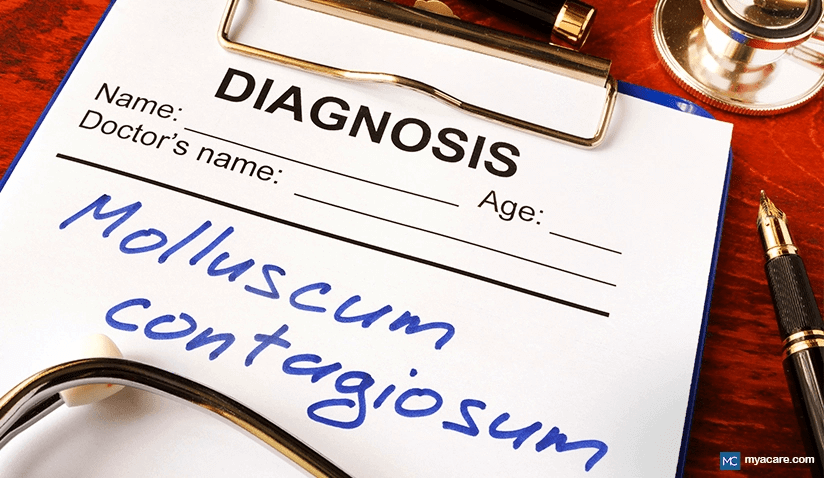Molluscum Contagiosum

What is Molluscum Contagiosum and What is its Cause?
Molluscum contagiosum is a benign skin condition caused by the poxvirus. Lesions appear as small bumps on the skin and can occur anywhere in the body. The virus is usually transferred via direct skin-to-skin contact, sexual activities, or through fomite transmission, wherein one can get infected by having contact with inanimate objects contaminated with the virus.
Molluscum lesions can spread via autoinoculation and koebnerization. This can happen when a person who already has the lesions can transfer it to other parts of his or her body by scratching a lesion and then touching or scratching an unaffected part of the body.
Who Can be Affected by Molluscum Contagiosum?
Molluscum contagiosum is most common in children and usually occurs before the age of fourteen (14). They usually catch viral infections from other infected children. Athletes, sexually active adults, and immunocompromised individuals such as those with HIV, are also commonly affected.
What are the Risk Factors?
- Children, especially those aged 1-10
- Having atopic dermatitis
- Living in warm, humid climates and crowded conditions
- Athletes who constantly have skin-to-skin contact
- Those who are immunocompromised (such as transplant, HIV/AIDS, or cancer patients)
- Adults who are sexually active
- Those taking immunosuppressants which can lower the body’s ability to fight infections
What are the Signs and Symptoms?
Lesions of molluscum contagiosum usually present as small raised bumps that may be pink, pearly, or skin-colored, with a central umbilication or central dell which contains a white curd-like material containing the virus. Lesions can occur anywhere on the body and may be solitary or can appear in groups. Sometimes, lesions can be red and inflamed. Scratching or manipulation of the lesions can lead to secondary bacterial infection.
How is it Diagnosed?
Diagnosis of molluscum contagiosum is usually straightforward. Dermatologists can also perform dermoscopy as an adjunct to support the diagnosis. When seen through the dermatoscope, lesions of molluscum contagiosum usually appear with a central polylobular white-yellow amorphous structure with a surrounding peripheral crown of blood vessels (red corona). It is also possible to perform PCR (polymerase chain reaction) confirmation, but this test is usually not mandatory, as the diagnosis can be based on the clinical picture.
Treatment and Management
In many cases of molluscum, the lesions are self-limiting and can go away on their own. However, for persistent, pruritic, or aesthetically-displeasing lesions, there are some forms of management available.
PHYSICAL TREATMENTS (PROCEDURES)
- Cryotherapy
- Curettage
- Laser therapy
TOPICAL THERAPY
- Podophyllotoxin cream
- Iodine and salicylic acid
- Potassium hydroxide
- Tretinoin
- Cantharidin
- Imiquimod
ORAL THERAPY
- Cimetidine
For immunocompromised patients with HIV/AIDS, boosting their immune status and increasing their CD4 cell counts through antiretroviral therapy can aid in the improvement of molluscum lesions.
It is highly recommended to visit a dermatologist before starting any of these treatments in order to be properly guided and advised.
What are the Possible Complications?
Molluscum lesions are generally benign and do not cause significant problems. However, for those who continuously scratch their lesions, a secondary bacterial infection may occur. For patients with atopic dermatitis, lesions may be accompanied by itch and rashes; and for those with eyelid lesions, conjunctivitis and punctate keratitis may develop.
Lesions of molluscum usually heal without scarring; but scarring may occur if the patient scratches, scrapes, or manipulates the lesions.
Prevention
- Observe proper handwashing techniques
- No scratching or picking on the lesions
- No sharing of personal items
- Cover lesions that are infected to avoid direct skin-to-skin contact
- Exercise caution during sports activities
- Consult with your dermatologist if there are any lesions present on the skin
Clinical Course and Prognosis
In healthy, immunocompetent individuals, lesions may resolve spontaneously within months to years (usually 6 - 18 months). HIV patients with molluscum will see improvement when their CD4 cell count also increases, and if treatment with antiretroviral therapy has been started. Overall, molluscum contagiosum lesions are relatively harmless. It is advisable to consult with a board-certified dermatologist for the treatment and management of these lesions.
To search for the best health providers for dermatology in Croatia, Germany, Greece, Italy, Malaysia, Singapore, Slovakia Spain, Thailand, The UAE, the UK, and the US, please use our free search engine.
To search for the best healthcare providers worldwide, please use the Mya Care search engine.
Dr. Lauren Livelo is a board-certified dermatologist from the Philippines. She has a degree in Medicine from the University of the East Ramon Magsaysay Memorial Medical Center, and has completed her dermatology residency training in the Research Institute for Tropical Medicine. Aside from her private practice, she enjoys writing about skin care and diseases of the skin.
References:
Featured Blogs



